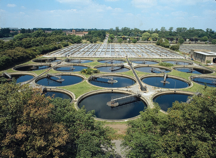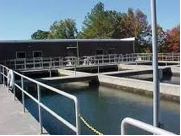|

Sewage treatment works
The key to successful working in treatment works is the experience of the team undertaking the work. The typical layout of pre-treatment, primary and secondary settling tanks and the sludge digester are all connected via a complicated but logical network of pipes that tends to be located deeper than in other environments. The network is usually quite intricate with many return feeds and valves. Unless the team undertaking the work has a good understanding of the logical flows associated with the treatment works then it will be difficult for them to give accurate information to the client.
There are a number of inherent dangers involved when working on sewage treatment works. The presence of aeration tanks and partially solidified sludge beds can pose a lethal threat to the untrained and inexperienced eye. All Adien staff are experienced and trained to observe and identify the dangers associated with working on such sites. Our staff hold Water Hygiene Certificates and are aware of industry standards, regulations and requirements. The use of asbestos fibres to reinforce concrete pipes makes the use of non-intrusive surveying techniques trial holes a far less hazardous option to choose over traditional trial pitting. This is an ideal example of where the use of ground probing radar reduces project risks immediately.
link to pdf of Sewage Treatment Works drawing
Water treatment works
These are characterised by large diameter pipes which lend themselves to detection through ground probing  radar and other non-intrusive techniques. Again, the experience of the team is essential to obtaining accurate results as the pipe flows are logical once you have worked out how it all works! Teams also need to be aware of the particular hazards of chemicals used for chlorination and disinfection. radar and other non-intrusive techniques. Again, the experience of the team is essential to obtaining accurate results as the pipe flows are logical once you have worked out how it all works! Teams also need to be aware of the particular hazards of chemicals used for chlorination and disinfection.
Many water treatment works are in a poor state of repair with electrical standards dating back to the 1950’s and run inefficiently compared to more modern sites. Today’s high demand for water means that the closure of a site or portion of a works due to inadequate buried service information could have catastrophic consequences for all parties involved. This emphasises the importance of having quality and accurate information, all of which Adien can provide.
link to pdf of Water Treatment Works drawing
Pumping stations and reservoirs
Pumping systems are an integral part of almost all waternetworks, both potable and dirty water. They have a very high volume of pipes and intricate valve networks that again make them a site that requires an experienced team to survey well. Tracing rising mains that are several metres underground requires both the right kind of equipment as well as the skills to interpret correctly the data being generated by that equipment. very high volume of pipes and intricate valve networks that again make them a site that requires an experienced team to survey well. Tracing rising mains that are several metres underground requires both the right kind of equipment as well as the skills to interpret correctly the data being generated by that equipment.
Link to pdf of Kew Pumping Station Drawing
|

